![]()
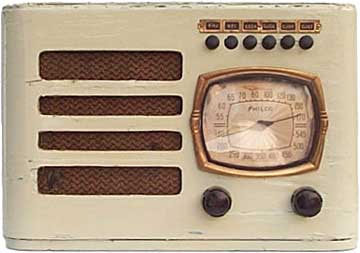
Philco
39-7
(unrestored)
ca. 1939
I bought this one from Ernest Yeaw, owner and operator of the Bayhead Radio Museum, for Cdn$20.00. I knew that I'd have to replace the veneer hiding under all that white enamel, because it's got some separated areas, and a couple of areas where it's broken right off.
On the other hand, the knobs, gold foil dial face, bezel, and button labels are all there in good shape. I'm not sure if the grille cloth is original, but it doesn't look brand new either. It is similar to one of the reproduction patterns available from AES. Maybe this was the original that the repro was copied from?
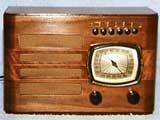 |
It should look something like this one, in Bob La Rocca's collection. Larry Dowell shows a 39-7 with a different grille, on his Radiodaze site, with "American Walnut and Zebrawood inlay". Great. Not only do I have to learn how to replace veneer, now there's inlay involved. We'll see what kind of pattern there is after I strip the paint off. |
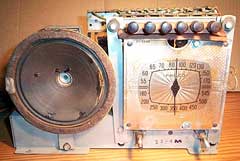 |
Front of the chassis, with speaker, dial, and pushbuttons. Even out of the cabinet, the pushbuttons were sticky, and half of them refused to pop out after another one was pushed in. I gave it a few short squirts of tuner cleaning spray, and all except for one of them behave. I'll try some ultra-light machine oil later. The labels on the cabinet are the call letters for stations KHJ (930 Los Angeles), KFI (640 Los Angeles), KECA (790 Los Angeles), CJCA (580 Edmonton) , CJBR (960 Regina), and CJAT (1200 Trail, BC). |
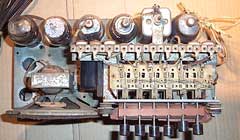 |
Top of the chassis. One Westinghouse and four Philco tubes. My wife said "The tubes look nice", and they do. |
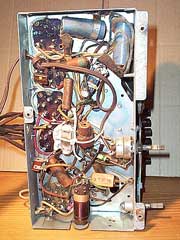 |
Bottom of the chassis. I recalled reading that the Philcos from the late '30s had rubber insulation on their wiring which has a tendency to rot and fall off after sixty years, so I didn't even think of plugging it in and turning it on just yet. Sure enough, a lot of the hookup wires had bare spots. See the article by Ron Ramirez:, "Rubber-covered wiring in 1939-1942 Philcos". |
 |
The two smaller knobs were on it when I bought it, and I thought they resembled the generic reproduction knobs available from AES. When I got it home, I compared them with one of the AES repros (larger one at the right), and decided they were original equipment. They've also got a bit of black paint on them, so now I really wonder what I'll find under the white paint. |
Back to John Rose's Vintage Radio Home